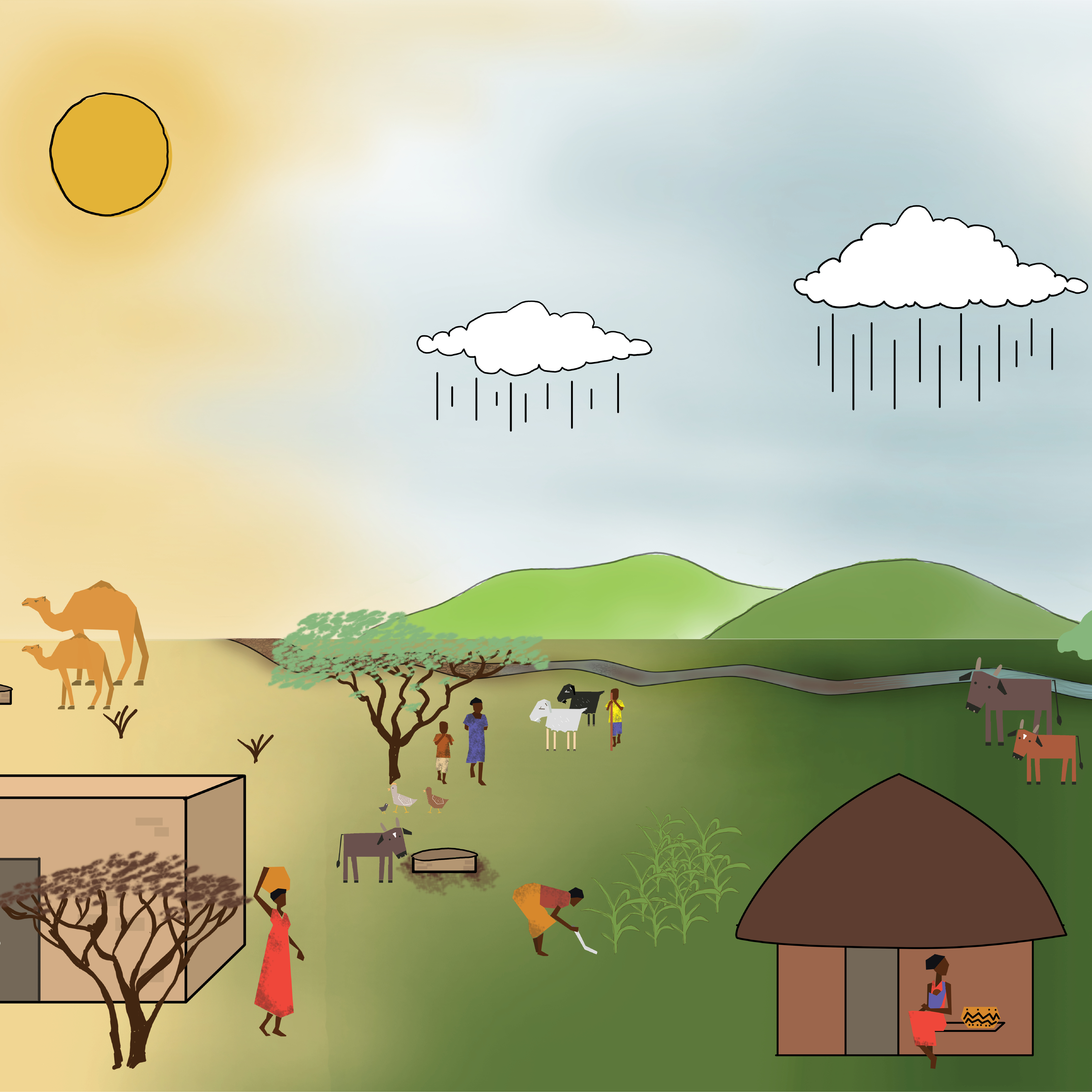Acute Malnutrition in Africa’s Drylands

High levels of persistent Global Acute Malnutrition are a problem across the Sahel and Horn of Africa, which are typically dryland regions. The Feinstein International Center and the Food and Agriculture Organization of the United Nations have co-produced a Food and Nutrition Bulletin Supplement, based on an adapted conceptual framework for analyzing and addressing acute malnutrition in Africa’s drylands and an earlier technical webinar series.
Supplement content
More than 30 authors have produced 9 research articles and 2 short research communications. The research encompasses a broad spectrum, ranging from multi-country studies focusing on systems and institutions to location specific primary research delving into the drivers of malnutrition.
Research articles explore the relationships between people, their livelihoods, and the environment. These relationships are mediated by systems and institutions, ultimately shaping the conditions or characteristics associated with acute malnutrition.
The adapted framework
The adapted conceptual framework for addressing acute malnutrition in Africa’s drylands incorporates the immediate and underlying drivers in the original UNICEF framework.
The adapted framework highlights the basic drivers of acute malnutrition, linked to livelihoods, seasonality and environment, and the systemic and institutional factors that drive vulnerability or mitigate it, or foster resilience. This focus on the basic drivers contrasts with the conventional approach, which primarily focuses on the individual and household-level characteristics associated with acute malnutrition.
What you measure really matters
Several papers identify mixed methods approaches to enhance our understanding of basic drivers and the interactions between systems, institutions, the environment, and livelihoods. While quantitative survey methods of nutritional outcomes and characteristics remain relevant, the analysis must progress further to consider geospatial and temporal granularity, and allow for disaggregation across communities and livelihood systems.
Implications
Analyzing these basic drivers can significantly enhance the design, timing and effectiveness of interventions aimed at reducing acute malnutrition. Simultaneously, it can shape systemic changes to mitigate the drivers of malnutrition. Therefore, program design must extend beyond a core package of nutrition -specific interventions and promote a more balanced approach encompassing treatment, prevention, as well as longer-term systems strengthening and institutional change.
Collectively and individually, the papers call for a paradigm shift in our understanding of child malnutrition. They underscore the pivotal role of systems and institutions in addressing the burden of acute malnutrition.
AbdalMonium Osman
Emergencies and Resilience Division
Food and Agriculture Organization of the United Nations
Patrizia Fracassi
Food and Nutrition Division
Food and Agriculture Organization of the United Nations
The following papers have been published as a Supplement to the December 2023 issue of Food and Nutrition Bulletin.
Foreword
Paul Howe, Lynnette Neufeld, Rein Paulsen, Shanda Steimer
Addressing the Basic Drivers of Acute Malnutrition
Helen Young, Nola Jenkins, AbdalMonium Osman, Patrizia Fracassi, and Anne Radday
A Relational Approach to the Drivers of Child Acute Malnutrition
Helen Young, Hussein Sulieman, Saverio Kra¨tli, and Abdalmonium Osman
Food and Power in Protracted Crisis: How Systems and Institutions Influence Livelihoods, Food Security, and Nutrition
Susanne Jaspars
Preventing Child Wasting in Africa’s Dryland: An Exploratory Review of the Enabling Environment in 8 Sub-Saharan
Countries Using a Food Systems Lens
Patrizia Fracassi, Morgane Daget, Sangmin Seo, and Riccardo D’Angeli
High Non-affordability of Diets and Malnutrition in Africa’s Drylands: Systems Analysis to Guide Action
Nora Hobbs, Julia Hug, and Saskia de Pee
Restoring Food Systems with Nutritious Native Plants: Experiences from the African Drylands
Moctar Sacande and Giulia Muir
Community Clustering of Food Insecurity and Malnutrition Associated With Systemic Drivers in Chad
Gwenaelle Luc, Modibo Keita, Fata Houssoube, Edgar Wabyona, Alain Constant, Assad Bori, Kareem Sadik, Anastasia Marshak, and Abdal Monium Osman
Forecasting Seasonal Acute Malnutrition: Setting the Framework
Elena N. Naumova
Seasonality of Acute Malnutrition in African Drylands: Evidence From 15 Years of SMART Surveys
Aishwarya Venkat, Anastasia Marshak, Helen Young, and Elena N. Naumova
The Complexity of the Seasonality of Nutritional Status: Two Annul Peaks in Child Wasting in Eastern CHAD
Anastasia Marshak, Helen Young, and Elena N. Naumova
The Livestock for Health Study: A Field Trial on Livestock Interventions to Prevent Acute Malnutrition Among Women and Children in Pastoralist Communities in Northern Kenya
SM Thumbi, Josphat Muema, Nyamai Mutono, Joseph Njuguna, Christine Jost, Erin Boyd, Daniel Tewoldeberhan, et al
Data on Humanitarian Crises: Who and What Are We Missing?
Anastasia Marshak, Helen Young, and Elena N. Naumova

Nutrition in Africa’s drylands: a conceptual framework for addressing acute malnutrition
This brief reviews and updates the generally accepted conceptual framework of drivers of acute malnutrition in Africa’s drylands, where emergency levels of global acute malnutrition stubbornly persist.

La nutrition dans les zones arides africaines : un cadre conceptuel pour lutter contre la malnutrition aiguë
Le présent document d’information examine et met à jour le cadre conceptuel généralement accepté des moteurs de la malnutrition aiguë dans les zones arides africaines, où continue d’exister obstinément un niveau critique de malnutrition aiguë globale.
FAO and Tufts co-hosted a technical series in October and November 2020 to review the basic drivers of malnutrition in Africa’s drylands and discuss an adapted conceptual framework for addressing acute malnutrition in Africa’s drylands.
Visit the series website for background on the series, welcome videos, recording of the events, and opportunities to get involved.
Panel 1: Basic drivers of acute malnutrition: environment and seasonality
Panel 2: Basic drivers of acute malnutrition: systems and institutions
Panel 4: Next steps: how can the drivers of persistent malnutrition shape the response?
